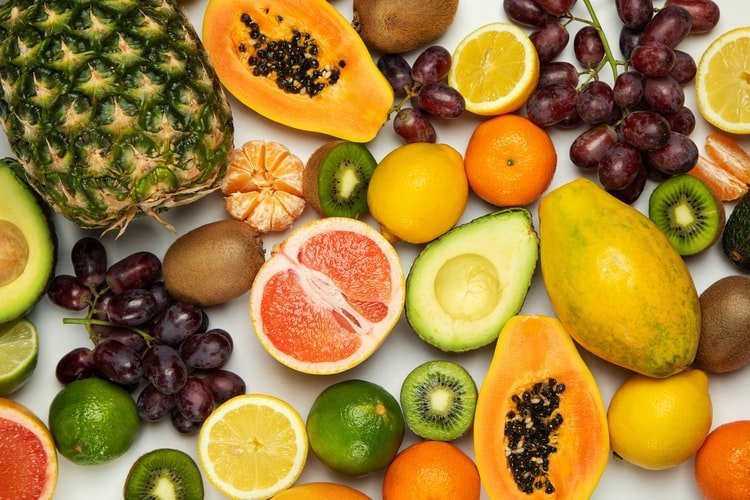
Fresh produce is high in vitamins, phytonutrients, and fiber, and should make up about half of your plate at each meal. Fortunately, it’s tasty. And by eating in season, you can enjoy your favorite fruits and vegetables at their best.
Leslie Bonci, RD, owner of Active Eating Advice, shares 10 foods to eat right now. From juicy peaches and watermelon to versatile summer squash, stock up on these fresh fruits and vegetables.
SUMMER FRUITS

Cantaloupe is delicious on its own, but Bonci suggests mixing it with cottage cheese and almonds. It’s a great breakfast or lunch option, and the protein keeps you full.
Look for cantaloupes that are heavy and smell sweet. When pressed with your thumb, the stem should yield slightly. Refrigerate cantaloupe in an airtight container once cut.
Nutrition: 1 cup of cantaloupe has 54 calories, 13 carbs, and 1 protein.

Wash some blueberries, keep them nearby, and eat them for a snack. Or mix them into a yogurt parfait, a smoothie, or a salad.
Pick berries that are plump, firm, and blue (red berries were picked too early and won’t ripen). Refrigerate blueberries and wash them with cold water before eating.
Nutrition: 8 calories, 21 carbs, and 1 protein per cup of blueberries

It’s easy to eat apples on the go, pack them in lunches, or slice them and serve them with a peanut butter dip. Bonci suggests using apple slices instead of graham crackers as the basis for a s’more during summer barbecues. Apples can also be added to coleslaw for a sweet crunch.
A firm apple with no bruising or cuts is ideal. Left out on the counter, apples quickly ripen, so store them in the crisper drawer of your fridge. Apples’ thin skin can absorb nearby flavors and odors, so keep them away from onions.
Nutrition: 100 calories and 25 grams of carbs per medium apple

Bonci’s favorite dish is a summer salad with peaches, mozzarella, and basil. You can also grill peaches as a tasty side dish with grilled meat and vegetables, or simply add them to Greek yogurt with granola.
Squeeze a peach to test for ripeness. The texture, color, and fragrance should all indicate that it’s ready to eat. A few more days for peaches Try putting them in a paper bag to speed up the process.
Nutrition: 1 medium peach has 39 calories, 14 carbs, and 1 protein gram.

Nothing says summer like a ripe watermelon. Snack on one or serve one at a barbecue. Watermelon goes well with feta cheese and spinach salads. Make a slushy with watermelon and strawberries.
Colors matter when choosing a watermelon. A watermelon with a shiny green skin and a green stem isn’t ripe. Instead, look for the light-colored “field patch” where the watermelon sat. It must be creamy and yellow. Refrigerate watermelon in an airtight container once cut.
Nutrition: 1 cup of watermelon has 40 calories and 10 carbs.

Summer tomatoes are delicious raw or cooked in a variety of ways. Make a caprese salad with mozzarella and basil, blend them into a fresh gazpacho, or roast them in the oven. Tomatoes are always a winner.
Opt for tomatoes that are firm in your hand but have some give near the stem. Avoid tomatoes with visible blemishes. Tomatoes should be stored stem-side down at room temperature until ripe. If you must refrigerate your tomatoes, only keep them for a few days (cold can degrade the flesh). Warm them up before eating.
Nutrition: 1 medium tomato has 25 calories and 5 g carbs.

Summer squashes are a plentiful summer veggie at this time of year. grilled with peppers, mushrooms, and onions, Bonci says. For a fun, healthy twist on fried zucchini, she suggests adding squash to kebabs or air-frying them with panko bread crumbs. Serve with a squeeze of lemon for a citrus kick.
Pick zucchini that is firm to the touch and has a stem still attached. Keep zucchini in the fridge for up to two weeks, and don’t wash it until you’re ready to eat it.
Nutrition: 1 cup of zucchini has 19 calories, 3 carbs, and 1 protein.

Raw green beans with red onion, tomatoes, and yellow peppers Sauté with garlic or add to a veggie tray with dip.
Pick firm, crisp green beans that snap cleanly in your hands. Unwashed produce can be kept in the crisper for up to a week. Drink plenty of cold water before eating.
Green beans have 34 calories, 8 carbs, and 2 protein per cup.

“I use the minis for hummus or Greek yogurt with dill,” Bonci says. You can also roast bell peppers, dice them into salads, or serve them chilled in a red pepper and peach gazpacho.
Opt for deep-colored, glossy bell peppers with no blemishes or soft spots. While they can be kept on the counter for a few days, bell peppers prefer the fridge. Keep them in the crisper for two weeks.
Red bell peppers have 39 calories, 9 carbs, and 1 protein per pepper.

Roasted, raw, or pickled beets add a punch of flavor to arugula with a citrus vinaigrette. Beets can also be juiced with other fruits and vegetables, or blended with spinach, pineapple juice, and berries for a quick vitamin boost.
Pick firm beets with a deep maroon color and bright green leaves. Refrigerate them unwashed for 2–3 weeks. If the greens begin to wilt or spoil, they may need to be removed.
Nutrition: 1 cup of beets has 58 calories, 13 carbs, and 2 protein.
VERDICT
We should all eat more fruits and vegetables, whether they are served fresh or roasted, as a main dish or as a side dish. Fortunately, each season offers new food options and peak produce. This summer, visit your local market and enjoy the delicious bounty of nature.

